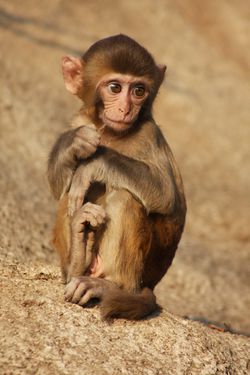Cercopithecine herpesvirus I
Out of the 35 herpesviruses that have been identified in nonhuman primates, only Cercopithecine herpesvirus 1, also known as Herpes B or B virus, has been identified as pathogenic for humans (5). Because of the B virus’s prevalence in macaques and other biomedical research animals, study of the B virus is important for several reasons. These reasons including understanding how it functions and whether or not it inhibits any kind of biomedical testing, its interspecial and intraspecial transmission abilities, and its potential harm both to its regular hosts and less common hosts, such as humans.
Viral Biology
The family of herpesviruses has been divided into three main categories: Alphaherpesvirinae, Betaherpesvirinae, and Gammaherpesvirinae. The three categories were originally separated based on biological and molecular properties of the viruses. The α-herpesviruses, of which Herpes B is a member, generally initiate infection in mucosal epithelial cells. They locally replicate, and later invade sensory neurons. It is here that they form a latent infection in ganglia near the area of inoculation. Most α-herpesviruses also replicate quickly compared to the other two categories. In species that are not their natural hosts, the α-herpesviruses can produce disease with neurological involvement (7). Because of these dangers regarding cross-species infections, the α-herpesvirus group is potentially a substantial problem in using nonhuman primates as biomedical models of human disease. Herpes B is the only one herpesvirus that has been identified so far that is a pathogenic for humans (5). It was also the first nonhuman primate herpesvirus to be identified (8).
B Virus in Non-Human Primates
B Virus in Humans
On October 22nd, 1932, a Dr. W. B. was engaged in experimental work on poliomyelitis when he was bitten on the dorsum of the left ring and little fingers by a Macacus rhesus monkey who appeared normal. The superficial wounds were treated with iodine and alcohol. Three days later, however, Dr. B. was experiencing pain, redness, and slight swelling at the wound sites. By October 28th, he was admitted to the hospital with lymphangitis and a 101.4 degree fever. After tetanus antitoxin injection had been administered and he appeared to improve in health, he obtained stomach cramps. By November 4th, he had hyperesthesia of the lower extremities and urinary retention. Over the next few days paralysis moved upwards from the lower extremities. Soon he has paresthesias in the upper extremities, a 104.8 degree fever, and he was put on a respirator for a diminishing respiratory rate. After a convulsion with laryngeal spasm, he lost consciousness and developed pulmonary edema. Despite medical support, he died on November 8th, just 18 days after receiving the bite (8).
This case was later found to be the first documented infection of Herpes B in a human.
References
1. Bailey, C.C. & Miller, A.D. Ulcerative Cheilitis in a Rhesus Macaque.Veterinary Pathology 49, 412-415 (2012).
2. Cohen, J. I., Davenport, D. S., Stewart, J. A., Deitchman, S., Hilliard, J. K., & Chapman, L. E. (2002). Recommendations for prevention of and therapy for exposure to B virus (cercopithecine herpesvirus 1). Clinical infectious diseases : an official publication of the Infectious Diseases Society of America, 35(10), 1191-1203.
3. Elmore, D. & Eberle, R. Monkey B virus (Cercopithecine herpesvirus 1).Comparative Medicine 58, 11-21 (2008).
4. Estep, R.D., Messaoudi, I. & Wong, S.W. Simian herpesviruses and their risk to humans. Vaccine 28, (2010).
5. Huff, J.L. & Barry, P.A. B-virus (Cercopithecine herpesvirus 1) infection in humans and macaques: Potential for zoonotic disease. Emerging Infectious Diseases 9, 246-250 (2003).
6. Weigler, B.J., Scinicariello, F. & Hilliard, J.K. Risk of venereal B virus (cercopithecine herpesvirus 1) transmission in rhesus monkeys using molecular epidemiology. The Journal of infectious diseases 171, 1139-1143 (1995).
7. Eberle, R. & Hilliard, J. The simian herpesviruses. Infectious agents and disease 4, 55-70 (1995).
8. Sabin, A. B., & Wright, A. M. (1934). ACUTE ASCENDING MYELITIS FOLLOWING A MONKEY BITE, WITH THE ISOLATION OF A VIRUS CAPABLE OF REPRODUCING THE DISEASE. The Journal of experimental medicine, 59(2), 115-136.
Edited by Alexis Boone, a student of Nora Sullivan in BIOL168L (Microbiology) in The Keck Science Department of the Claremont Colleges Spring 2014.

